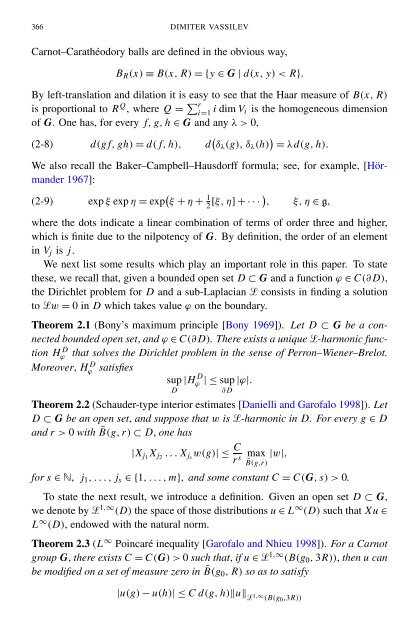Regularity near the characteristic boundary for sub-laplacian operators
Regularity near the characteristic boundary for sub-laplacian operators
Regularity near the characteristic boundary for sub-laplacian operators
You also want an ePaper? Increase the reach of your titles
YUMPU automatically turns print PDFs into web optimized ePapers that Google loves.
366 DIMITER VASSILEV<br />
Carnot–Carathéodory balls are defined in <strong>the</strong> obvious way,<br />
B R (x) ≡ B(x, R) = {y ∈ G | d(x, y) < R}.<br />
By left-translation and dilation it is easy to see that <strong>the</strong> Haar measure of B(x, R)<br />
is proportional to R Q , where Q = ∑ r<br />
i=1 i dim V i is <strong>the</strong> homogeneous dimension<br />
of G. One has, <strong>for</strong> every f, g, h ∈ G and any λ > 0,<br />
(2-8) d(g f, gh) = d( f, h), d ( δ λ (g), δ λ (h) ) = λd(g, h).<br />
We also recall <strong>the</strong> Baker–Campbell–Hausdorff <strong>for</strong>mula; see, <strong>for</strong> example, [Hörmander<br />
1967]:<br />
(2-9) exp ξ exp η = exp ( ξ + η + 1 2 [ξ, η] + · · · ),<br />
ξ, η ∈ g,<br />
where <strong>the</strong> dots indicate a li<strong>near</strong> combination of terms of order three and higher,<br />
which is finite due to <strong>the</strong> nilpotency of G. By definition, <strong>the</strong> order of an element<br />
in V j is j.<br />
We next list some results which play an important role in this paper. To state<br />
<strong>the</strong>se, we recall that, given a bounded open set D ⊂ G and a function ϕ ∈ C(∂ D),<br />
<strong>the</strong> Dirichlet problem <strong>for</strong> D and a <strong>sub</strong>-Laplacian consists in finding a solution<br />
to w = 0 in D which takes value ϕ on <strong>the</strong> <strong>boundary</strong>.<br />
Theorem 2.1 (Bony’s maximum principle [Bony 1969]). Let D ⊂ G be a connected<br />
bounded open set, and ϕ ∈ C(∂ D). There exists a unique -harmonic function<br />
Hϕ<br />
D that solves <strong>the</strong> Dirichlet problem in <strong>the</strong> sense of Perron–Wiener–Brelot.<br />
Moreover, Hϕ D satisfies sup |Hϕ D | ≤ sup |ϕ|.<br />
D<br />
∂ D<br />
Theorem 2.2 (Schauder-type interior estimates [Danielli and Garofalo 1998]). Let<br />
D ⊂ G be an open set, and suppose that w is -harmonic in D. For every g ∈ D<br />
and r > 0 with ¯B(g, r) ⊂ D, one has<br />
|X j1 X j2 . . . X js w(g)| ≤ C r s max |w|,<br />
¯B(g,r)<br />
<strong>for</strong> s ∈ , j 1 , . . . , j s ∈ {1, . . . , m}, and some constant C = C(G, s) > 0.<br />
To state <strong>the</strong> next result, we introduce a definition. Given an open set D ⊂ G,<br />
we denote by 1,∞ (D) <strong>the</strong> space of those distributions u ∈ L ∞ (D) such that Xu ∈<br />
L ∞ (D), endowed with <strong>the</strong> natural norm.<br />
Theorem 2.3 (L ∞ Poincaré inequality [Garofalo and Nhieu 1998]). For a Carnot<br />
group G, <strong>the</strong>re exists C = C(G) > 0 such that, if u ∈ 1,∞ (B(g 0 , 3R)), <strong>the</strong>n u can<br />
be modified on a set of measure zero in ¯B(g 0 , R) so as to satisfy<br />
|u(g) − u(h)| ≤ C d(g, h)‖u‖ 1,∞ (B(g 0 ,3R))
















